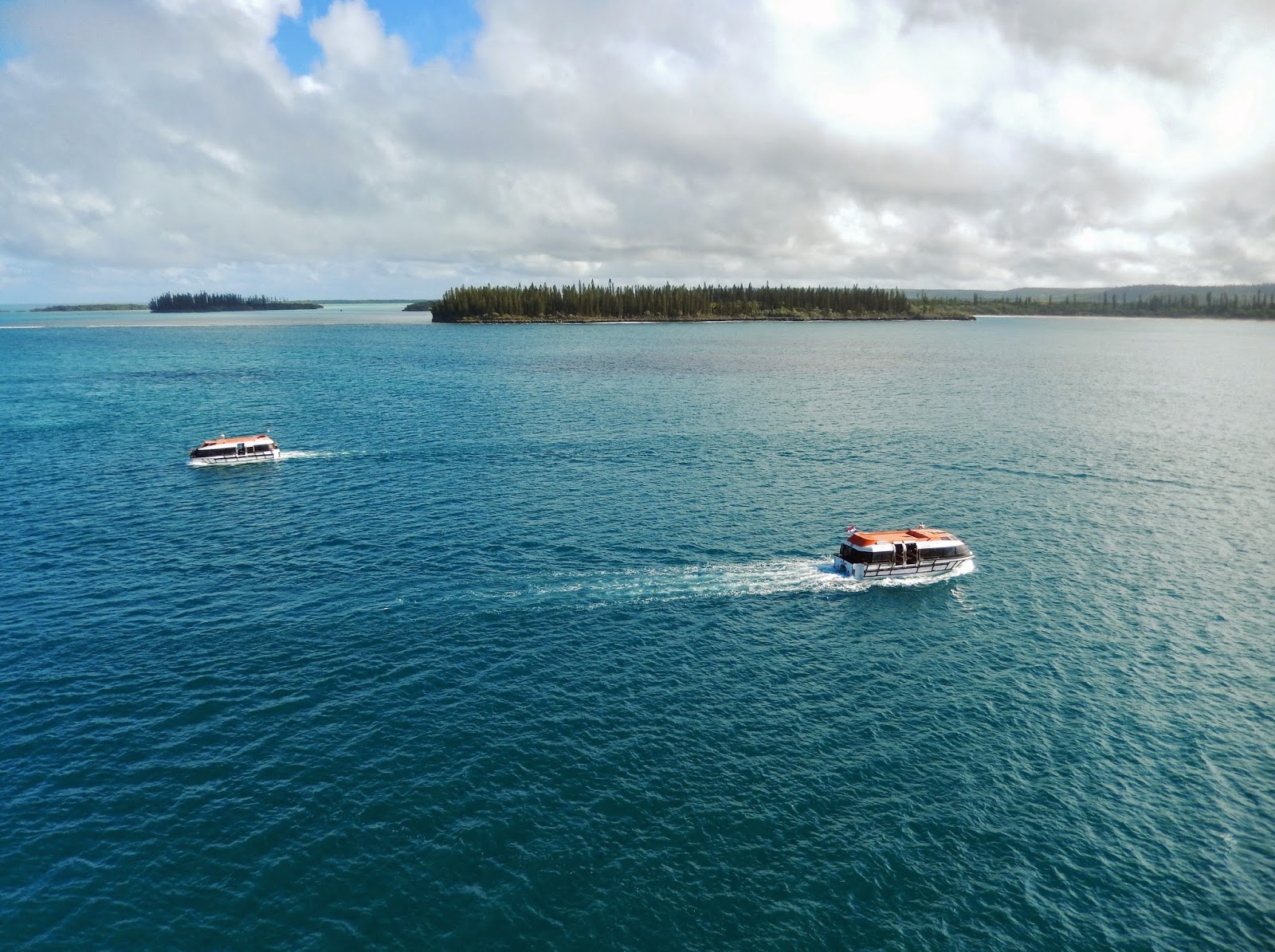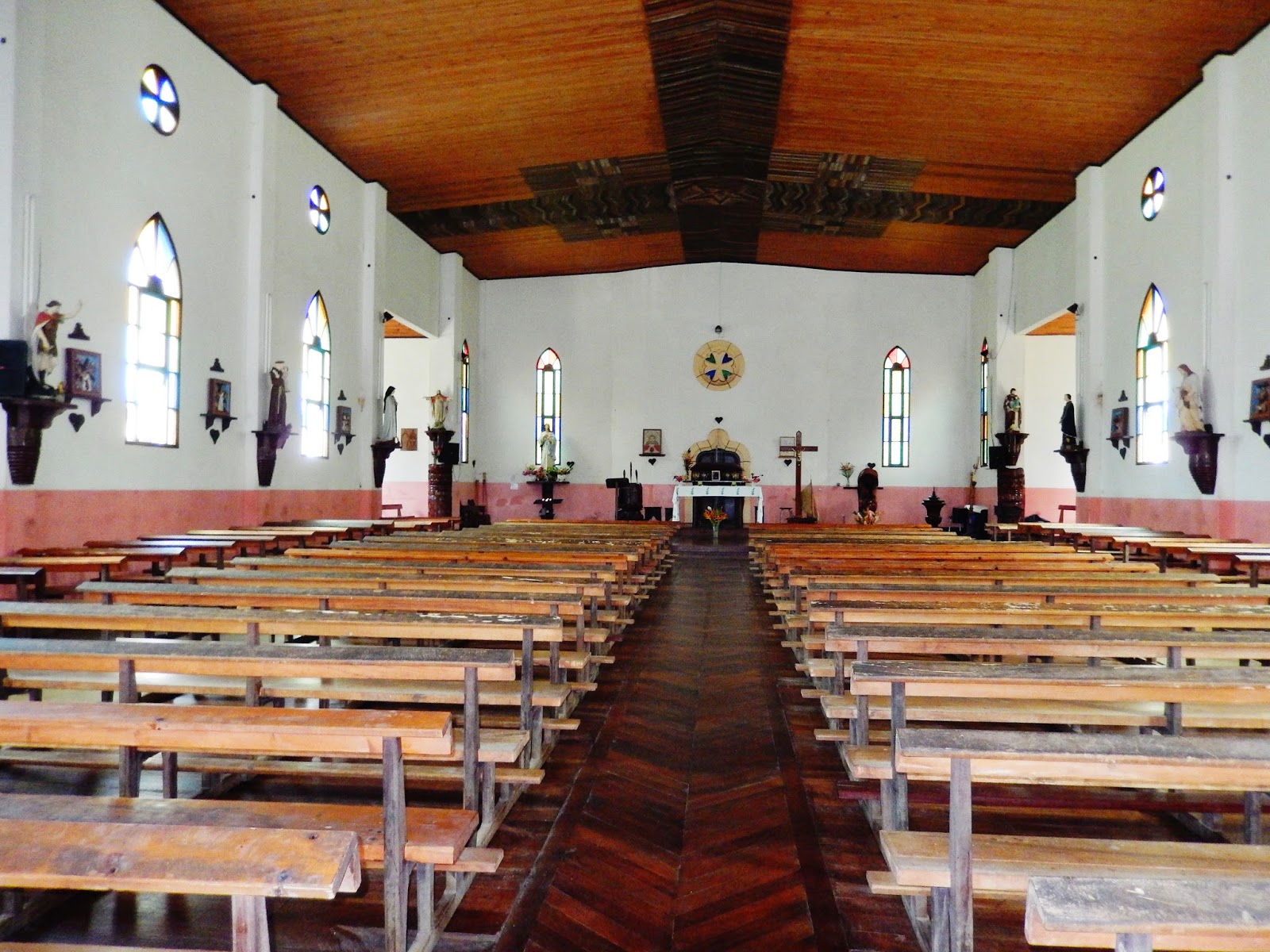Our ship departed Noumea, New Caledonia, about 7:00 PM on Friday, February 7th,
but didn’t travel far. By 8:00 AM on Saturday February 8th, we were
anchored in Kuto Bay off “Ile des Pins” (Isle of Pines), New Caledonia.
Ile des Pins is a small island just off the southern tip of Grand Terre—which is the largest and most populated island in the New Caledonia island group. The first European to visit the island was Captain James Cook in 1774 during his second voyage to New Zealand. Cook gave the island its name after seeing the tall native pines (Araucaria columnaris)—a relative of the “Monkey Puzzle” tree—which were unlike other trees he had seen in New Caledonia. He never disembarked onto the island, but since he saw signs of inhabitance (smoke), he assumed it was inhabited.
In the 1840s Protestant and Catholic missionaries arrived, along with merchants seeking sandalwood. The French took possession of the island in 1853, at which time the native Kunies opted for the Catholic religion. In 1872 the island became a French penal colony, home to 3,000 political deportees from the Paris Commune.
Since we were anchored, this was a tender port—meaning we had to take a tender (which doubles as a life boat) from our ship to a small dock on shore. This was also the last chance we would have to share a port with our friends Al and Erica Wehrle, since they would depart our ship and return home to the U.S upon arrival in Sydney, Australia. We once again decided to tour this port “on our own” and not take a tour organized by Holland America. Exploring a port on our own might mean we don’t see quite as much, but what we do see is our own choice and at our own pace. And on our own there is always the possibility of serendipity—of discovering an unexpected gem that we wouldn’t have seen otherwise. “Last Tender” was at 2:30 PM, so we wanted to get onto the island early and make the most of our time there.
We, along with Al and Erica, took an early tender, and were on the island by about 9:00 AM. As we walked down the dock of the tender port and into the tiny town of Kuto, we were greeted with the traditional dance, costumes, and music of the Kanak—the indigenous New Caledonians. (Total population on the island is about 2,000 people.) This was a wonderful start to our visit and brought home the point that this really was an exotic place far from home.
On shore near the dock were stalls where the Kanak (most of the inhabitants of Ile des Pins are Melanesian Kanak) were selling sarongs, wood carvings, and other trinkets—similar to the other islands in the South Pacific we visited. We took a quick look but didn’t buy anything—we really didn’t want to come home with suitcases full of souvenirs like we did after our 2012 cruise—and then noticed a beautiful beach and hotel on Baie de Kuto (Bay of Kuto) which was within walking distance to the north. We made note that this would be a good place to end our day and then proceeded to walk up the hill and out of the town of Kuto—signs in town indicated that a gift shop was in that direction. We reached the “gift shop”, which was really was just more outdoor stalls selling the same stuff as we saw down by the dock.
We decided to go back down the hill by a different path, but we, along with others quickly met with an obstacle. On the road down was a bull tethered to a pole with a long chain. And the bull was ornery and not inclined to let us pass—he even demonstrated the classic behavior of “pawing” at the ground with his front hoof. A few people—including Al—ran quickly by the bull when its attention was distracted elsewhere, but most of us were not quite so fleet afoot and chose to wait out of reach and contemplate our options. Fortunately, the bull’s owner soon came by and forced it back into its field with a few bangs over its head. In retrospect, the bull was most likely enjoying his game of terrorizing tourists!
Safely past the bull, we returned to Kuto and saw some vendors offering independent tours. The four of us plus another couple from New Zealand chose one that would take us to see some of the local highlights, and for about $10 each, we were off in a van for a one hour tour that really turned out to be two hours.
Our tour took us east along the coast of the island from Kuto to Vao—the largest town on the island. Along the way, we stopped for views and photos—including “Brush Island”—which looks like a hair brush with trees at one end and a handle at the other. In Vao, we saw the Mayor’s office and the historic and beautifully preserved Catholic Church—Notre Dame de l’Assomption--made entirely of wood. Yards and gardens around the town contained driftwood sticks and logs that had been carved with faces and stuck vertically into the ground, and fences—also made of driftwood—had fence posts connected at the top with rope—quite unique and something we had never seen before.
After visiting Vao, we continued on to Baie de St. Joseph (St. Joseph’s Bay) and had some beautiful views of the bay and traditional sailing outriggers made from the local pine—also called Kohu. Further on, we reached Baie de Maurice (Maurice Bay), stopping at the St. Maurice Memorial—a commemoration of the first catholic service on the island and a proud symbol of Melanesian culture and identity.
At this point it was time to start heading back, but before ending our tour, we stopped at the Penal Colony Prison about 1 mile north of Kuto in Ouro. The prison was in ruins, but from what was left, it could be seen that the prisoners had a very stark and harsh existence.
Our tour dropped us off at the restaurant/hotel we noticed earlier--Oure Hotel Restaurant--which was right on the beach at Kuto Bay. We were fortunate to get a table on the deck with a beautiful view of the sandy beach and the bay. And it was a perfect place to have lunch and an adult beverage (beer.) The beer wasn’t cheap ($12/can!), but the setting made it well worthwhile. Later Bill went in for a swim while Pat, Al, and Erica relaxed on the deck.
As time got closer to 2:00 PM, it was time to walk back to the tender port. Along the way, we saw numerous Kanak families cooking and selling wares on the beach—but this time the sales were geared towards other Kanaks rather than tourists. So this gave a brief, but important, window into the Kanak culture. And along the way we had a view of Kanumera Bay with a beautiful limestone island.
We boarded our tender about 2:00 PM, and it soon whisked us back to the Amsterdam. The sail-away party started at 2:30 PM—in which we fully participated—and we departed Ile des Pins, New Caledonia about 3:00 PM. This was our last South Pacific Island port of call—after departure, we would have two full sea days before our next port of call—Sydney, Australia, on Tuesday, February 11th.

















































